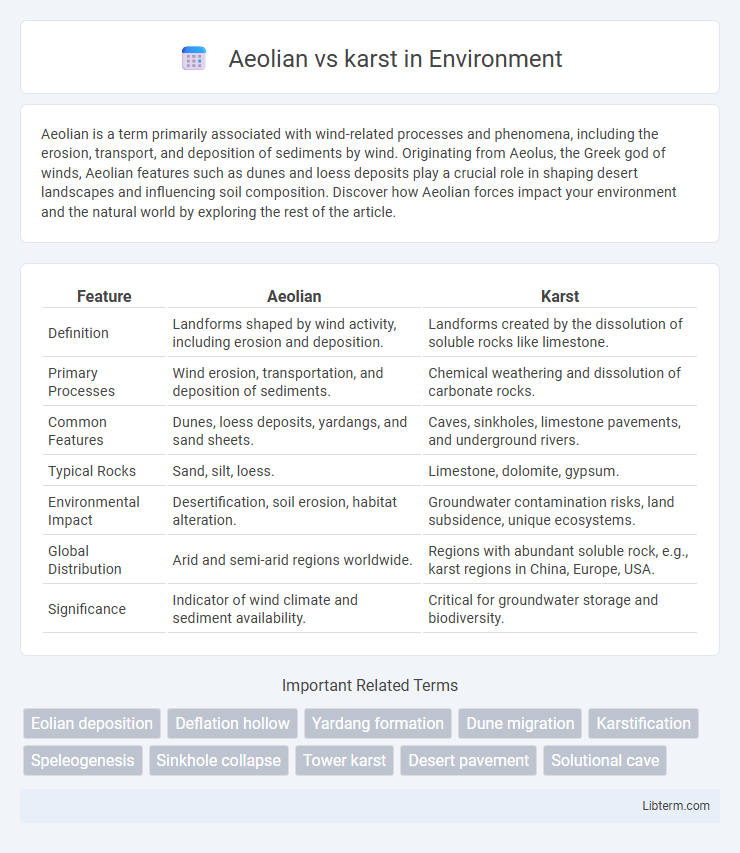Aeolian is a term primarily associated with wind-related processes and phenomena, including the erosion, transport, and deposition of sediments by wind. Originating from Aeolus, the Greek god of winds, Aeolian features such as dunes and loess deposits play a crucial role in shaping desert landscapes and influencing soil composition. Discover how Aeolian forces impact your environment and the natural world by exploring the rest of the article.
Table of Comparison
| Feature | Aeolian | Karst |
|---|---|---|
| Definition | Landforms shaped by wind activity, including erosion and deposition. | Landforms created by the dissolution of soluble rocks like limestone. |
| Primary Processes | Wind erosion, transportation, and deposition of sediments. | Chemical weathering and dissolution of carbonate rocks. |
| Common Features | Dunes, loess deposits, yardangs, and sand sheets. | Caves, sinkholes, limestone pavements, and underground rivers. |
| Typical Rocks | Sand, silt, loess. | Limestone, dolomite, gypsum. |
| Environmental Impact | Desertification, soil erosion, habitat alteration. | Groundwater contamination risks, land subsidence, unique ecosystems. |
| Global Distribution | Arid and semi-arid regions worldwide. | Regions with abundant soluble rock, e.g., karst regions in China, Europe, USA. |
| Significance | Indicator of wind climate and sediment availability. | Critical for groundwater storage and biodiversity. |
Overview of Aeolian and Karst Landscapes
Aeolian landscapes are shaped by wind-driven processes, featuring landforms such as sand dunes, loess deposits, and desert pavements predominantly found in arid and semi-arid regions. Karst landscapes develop through the chemical dissolution of soluble rocks like limestone, dolomite, and gypsum, resulting in distinctive features including sinkholes, caves, underground rivers, and rugged terrain. Both landscapes demonstrate erosion and sediment transport but differ fundamentally in their formative agents--wind for Aeolian environments and water-driven chemical weathering for karst systems.
Key Processes in Aeolian Landform Formation
Aeolian landform formation is primarily driven by wind erosion, transportation, and deposition, which shape features such as dunes, loess deposits, and yardangs. Key processes include deflation, where loose particles are lifted and removed, and abrasion, where transported sediments grind against surfaces, sculpting the landscape. These mechanisms contrast with karst processes that rely on chemical dissolution of soluble rocks like limestone, emphasizing physical wind activity in aeolian environments.
Key Processes in Karst Landform Development
Karst landform development primarily involves the dissolution of soluble rocks such as limestone, dolomite, and gypsum by natural acids in rainwater and groundwater, leading to features like sinkholes, caves, and underground drainage systems. Chemical weathering processes, especially carbonation and solution, play a critical role in enlarging fractures and bedding planes within the rock, promoting subterranean void formation. Unlike Aeolian processes driven by wind erosion and sediment transport, karst landscapes evolve through complex hydrogeological interactions and rock-water chemistry.
Types of Aeolian Landforms
Aeolian landforms primarily include dunes, such as barchan, transverse, longitudinal, and star dunes, shaped by wind-driven sand movement in arid environments. Other notable Aeolian features are loess deposits, which consist of fine silt accumulated by wind, and yardangs, streamlined ridges carved from bedrock through aeolian erosion. These formations contrast with karst landscapes, which are characterized by dissolution features like sinkholes, caves, and limestone pavements formed by chemical weathering of soluble rocks.
Types of Karst Landforms
Karst landforms are primarily characterized by features such as sinkholes, caves, and underground drainage systems formed by the dissolution of soluble rocks like limestone, dolomite, and gypsum. Unlike Aeolian landforms shaped by wind erosion and deposition, karst landscapes often showcase distinctive structures such as dolines, disappearing streams, and limestone pavements. These formations result from chemical weathering and hydrological processes, creating unique terrains that influence groundwater flow and surface morphology.
Environmental Conditions Favoring Aeolian Features
Aeolian features predominantly develop in arid and semi-arid environments where sparse vegetation and loose, unconsolidated sediments allow wind to erode, transport, and deposit materials. These conditions include dry climates with strong, persistent winds and minimal surface moisture that limits soil cohesion. In contrast, karst landscapes form primarily in humid regions with abundant rainfall, promoting chemical weathering of soluble rocks like limestone.
Environmental Conditions Favoring Karst Features
Karst landscapes develop primarily in regions with abundant rainfall and soluble carbonate bedrock such as limestone, promoting chemical weathering and underground drainage systems. Humid to subhumid climates enhance the dissolution processes, leading to sinkholes, caves, and underground rivers typical of karst terrains. In contrast, Aeolian processes dominate in arid or semi-arid environments where wind erosion and sediment transport shape dunes and desert pavements.
Aeolian vs Karst: Comparative Characteristics
Aeolian landscapes are primarily shaped by wind erosion and deposition, resulting in features like dunes and loess plains, whereas karst terrains form through the chemical dissolution of soluble rocks such as limestone, creating sinkholes, caves, and underground drainage systems. Aeolian processes are dominant in arid and semi-arid regions with loose, dry sediments, while karst development occurs in humid climates with abundant groundwater facilitating rock solubility. The sediment transport in Aeolian environments is typically airborne dust and sand, contrasting with karst systems characterized by subsurface water flow and chemical weathering.
Impacts of Aeolian and Karst Landscapes on Human Activity
Aeolian landscapes, shaped by wind-driven processes, impact human activity by influencing agricultural practices through soil erosion and sand dune migration, which can reduce arable land and damage infrastructure. Karst landscapes, characterized by soluble rock formations such as limestone, affect water availability and quality due to underground drainage systems and the presence of caves, making groundwater management crucial for communities. Both landscape types demand specialized land use strategies to mitigate environmental hazards and sustain human settlements.
Conservation and Management of Aeolian and Karst Regions
Conservation and management of Aeolian and Karst regions require tailored approaches due to their unique geological characteristics. Aeolian landscapes, shaped by wind-driven processes, demand strategies that prevent soil erosion and protect fragile dune ecosystems from human-induced disturbances. Karst regions, characterized by soluble rock formations and underground drainage systems, necessitate careful water resource management and pollution control to preserve caves, sinkholes, and biodiversity hotspots.
Aeolian Infographic

 libterm.com
libterm.com